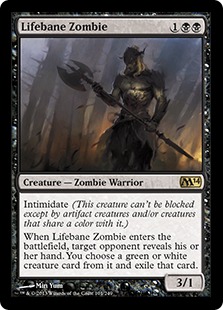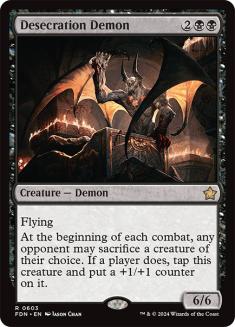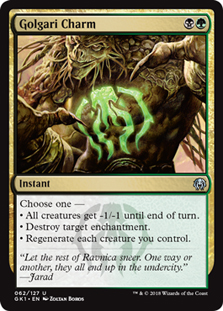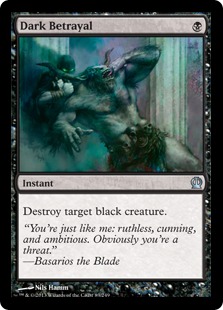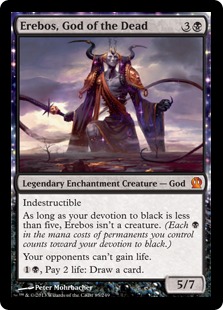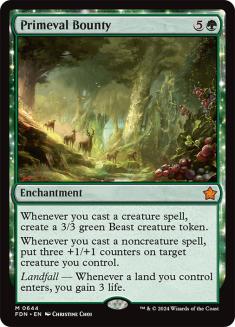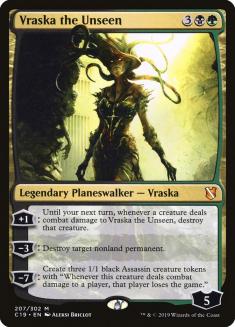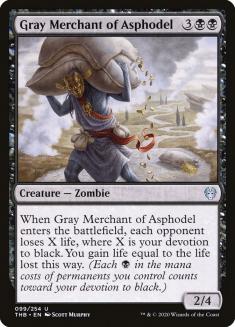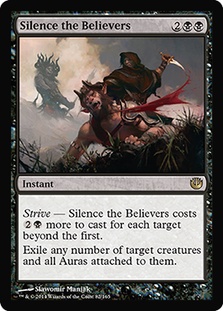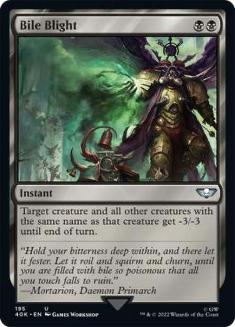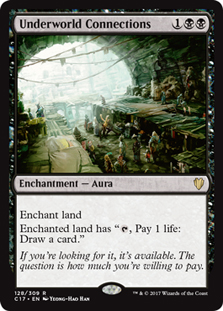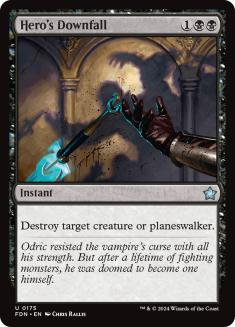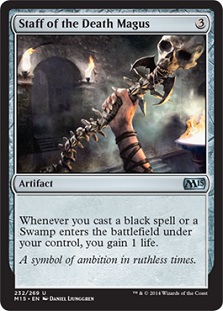This past weekend there was a Pro Tour in Atlanta, GA. Sadly, I did not end up qualified for that PT (it’s been too long!). Luckily for me, there was the
StarCityGames.com State Championship, and other than watching Reid Duke make his first PT T8, I had nothing else on the agenda. The lovely and talented
Thea Steele was interested, so we made a plan to play in States and possibly playtest by playing in a Friday Night Magic beforehand. It sounded like fun.
Even though States is a somewhat casual event, I still wanted to win. I could have blown it off as an excuse to “have fun” and played Mono-Green Devotion
which I really like but have no confidence in. I decided I could use the practice for the upcoming Invitational anyway and played the “Best Deck,” the
Mono-Black Devotion deck that splashes green. At this point I have to call it the best deck because it isn’t really even a competition anymore, and while I
will spend a considerable amount of time trying to come up with a successful anti-Mono Black strategy I am not convinced I, or anyone else for that matter,
will find one. Back to the point, though, I was confident I’d be giving myself a great chance to actually win the event by playing the black deck.
So far, I believe I have not heard of a higher attendance number than the attendance in Washington State, which was 165 people. Here is the deck I won the
tournament with, courtesy of Gerry Thompson.
Creatures (16)
Lands (25)
Spells (19)

At the Friday Night Magic the night before, I played two Drown in Sorrow and no copies of Silence the Believers, but for the most part, this is going to
look pretty similar to you if you’ve been following the metagame. Andrew Tenjum set the tone for the format early on with his win in Cincinnati, and it
seems like the field is still trying to catch up.
I’d like to give GerryT as much credit as possible for some of the ideas here.
He wrote about this deck and his choices a few weeks ago
, and I’d recommend reading it if you’re interested in how to play with or against this deck. In general, I’d recommend devouring as much of the “good”
Magic content as you can in preparation for an event, be it a Friday Night Magic or a Pro Tour. It’s not hard to learn something from a well written
article.
4 Lifebane Zombie, 0 Nightveil Specter.
This is the biggest difference between this list and some of the other successful lists I’ve seen. I also think it will be one of the biggest
differentiators of black decks, as they all converge upon the same configuration. Lifebane Zombie is essentially dead in the mirror match while Nightveil
Specter is a must-kill. Nightveil Specter also helps you tremendously against R/W Burm, whereas Lifebane Zombie is barely even a card. Nightveil Specter is
a great threat against control decks, whereas Lifebane Zombie can only give you information and provide something that’s hard to block to maybe pressure
Planeswalkers. Going forward, I’m not sure which one I would recommend. Given the field I played against, I can’t say I was unhappy with the Lifebane
Zombies, but I’m not sure what the field will be this weekend, other than to say there will be black decks and there will be people trying to beat the
black decks. That being said, if people do decide to bring back Nightveil Specter, it may become important to run additional Dark Betrayals in the
sideboard.
What Lifebane Zombie does is three-fold. First and foremost you get to look at your opponent’s hand. Knowing what your opponent is up to makes it much
easier to play the game in the best possible way. Obviously, it can also remove a green or white creature from your opponent’s hand. This is the reason I
think splashing white into the black deck (for Obzedat, or Blood Baron) or even playing the Junk color midrange deck (targets a-plenty!) is a bad idea.
Finally, it can attack Planeswalkers. The decks with Planeswalkers don’t really have black creatures to block with, so it can attack relatively unimpeded.
This is especially important against Mono-Blue-Devotion and U/W Control.
3 Hero’s Downfall.
Hero’s Downfall is obviously a great card, being good against basically every kind of opponent and providing you with answers to both hard-to-kill
creatures (Obzedat, Ghost Council, for example) as well as Planeswalkers like Elspeth, Sun’s Champion without requiring a combat step. That being said, it
costs three mana and will often cost you tempo as well. Whenever you’re on the draw, it’s always dangerous to draw multiple Hero’s Downfalls and it’s also
not particularly good against control decks despite being able to kill their Planeswalkers. Planeswalkers in Standard usually generate at least one card’s
worth of card advantage whenever they’re activated, so Downfalling one after the fact is not ideal. I could see wanting the fourth Downfall if Jund
Monsters begins to creep out of the woodwork, as you have somewhat limited answers to deal with Polukranos, Stormbreath Dragon, or a tapped-out Reaper of
the Wilds. In combination with pressuring your supply of Hero’s Downfalls with Planeswalkers, you will often find yourself hoping to draw Hero’s Downfall,
provided you are not stuck on two lands. If you are, you will probably draw Hero’s Downfall and wish you were drawing anything else.
I cut the Vraska the Unseen from the maindeck and relegated her to the sideboard at the behest of Gerry. I wanted to play it main because I like the way it
interacts with opposing Planeswalkers, but really, the best reason to play her is to kill enchantments, and you have three copies of Abrupt Decay to kill
the Banishing Lights and Detention Spheres you’ll face. I was happy to have access to a Vraska in my sideboard, though.
I played just one Dark Betrayal in my sideboard at this event, despite having played four in the past. This is just not an efficient use of sideboard
space. The card is optimal and forces decks to be built differently or sideboarded with differently, but in a world where I want to jam 20 or 30 cards into
my sideboard, it’s an easy thing to give up. Most notably, if people revive Nightveil Specter, it may become necessary to run more Dark Betrayals, as
having a reliable answer to that card is paramount in the matchup.
Primeval Bounty won me a match or two on its own and it’s a great card that I’ve always admired from afar. I’ve tried to put it in a few decks, decks where
it did not belong, and of course, I’ve drafted it a few times, once even on Day Two of a GP. Well, no longer. Now I get to play it in the sideboard of the
best deck in the format, so sign me up. The downside is that while it was once a huge potential trump card in the mirror, it now dies to Golgari Charm like
so many Underworld Connections. Still, I think it’s worthwhile for its other applications and for the fact that if they’ve spent their Golgari Charms or
they don’t draw another one, they will lose to it outright.
Silence the Believers was a nice card for me whenever I drew it. I never got to kill a Boon Satyr or anything like that, but the potential to remove Herald
of Torment could be relevant. Instead, it was a great topdeck in the midgame in my T8 and T4 matches and let me kill a couple of 4/4s that I otherwise
would not have been able to remove in an advantageous fashion, or perhaps at all.
Staff of the Death Magus was a concession to the potential Burn decks that may have run rampant at States. I think people are more likely to play what they
like, play what they have, or play what they can get at States due to its more casual nature, and that may lend itself to a larger presence of Burn decks
in the room than may be a normal representation of the format. With Gray Merchant of Asphodel and carefully playing around Skullcrack, the matchup is not
that hard to navigate, but the Staves legitimately make it favorable. Skullcrack will no longer matter as you will be gaining two life per turn, offsetting
whatever they do. Plus, you can board out Thoughtseize for Duress as a way to pad your life total.
Let’s look at what I played against, starting with the FNM:
1. UWR Control (2-0)
2. G/W Aggro (2-0)
3. 4-Color Enchantress (0-0-1)
4. UW control (2-1)
None of these decks especially stood out to me. I intentionally drew with Thea here so that we could maximize our potential prize-packs. The deck she was
playing was Eidolon of Blossoms based with Detention Spheres and Banishing Lights. In our playtest games the matchup seemed pretty favorable, but I was
relentless in my pursuit of killing all the Eidolon of Blossoms and didn’t really care about much else, which is how I would recommend approaching the
matchup in the future.
1. BW Enchantments (2-0)
2. Junk Enchantress [Special brew] (2-1)
3. Grixis Control (2-0)
4. Naya Fabled Hero (2-1)
5. BW Midrange (0-2)
6. Junk Midrange (2-0)
7. UW Control (2-0)
8. ID with BURN (0-0-1)
8th Seed going into the T8.
9. Jund Monsters (2-1)
10. Jund Monsters (2-0)
11. BW Midrange [revenge from Round 5] (2-0)
In Round 1, I played against an enchantment deck that didn’t draw cards off of its enchantments, which made the matchup very easy. It’s hard to stop every
Pack Rat and every Underworld Connections when you’re just one-for-one each time. In Round 2, I played an upgraded version of the Enchantress deck, the
scariest version I’ve seen so far. I don’t have the list, but the deck contained Odunos River Trawler as a potential way to recur Eidolon of Blossoms and
it had Nylea’s Presence for fixing as well as Ethereal Armor for aggression. I thought it was a cool deck and maybe one to look out for in the future.
Ultimately I got to play first in Game 3 and I had a normal draw with Thoughtseize and Lifebane Zombie. Black Devotion is an especially good spoiler to
synergy-based decks with the presence of four Thoughtseize, and if the Lifebane Zombies are live, it’s even better. I’m not saying this is a good thing for
the format or anything like that, merely that it is currently the case.
Round 3 featured an unremarkable match against a non-white control deck, and while Opportunity is scary, not playing against Sphinx’s Revelation is
decidedly un-scary. The rest of the matches I played were fairly normal in the way they played out. I broke serve a few times, winning on the draw in Game
3 when I needed to. Everyone always says you have to get lucky to win a tournament and that’s true, but you also have to give yourself the best chance to
do so and thus I will again recommend you play the black deck.
For all of my T8 rounds I was on the draw, being eighth seed, which was unfortunate. In Round 9, the games that I won felt close, and I didn’t play a third
land in Game 2 while he played a lot of large creatures and destroyed my face. In Round 10, my opponent’s draws were downright terrible, and while he
didn’t seem to be too upset about it, I was definitely pleased to escape what I think can be a tough matchup. In the finals I got revenge against the
ridiculous fellow who beat me in Round 5.
It’s worth noting that both of the Jund Monsters decks seemed to have a lot more black cards, even if only in the sideboard; I am not sure it’s a good idea
to play cards with casting costs featuring RR, GG, and BB in the same deck, even if only after sideboard, and I am sure that their stumbling on mana may
have let me get ahead in an otherwise close matchup. In the finals my opponent was playing a normal B/W Midrange deck, which ordinarily might have an
advantage in the matchup if not for Lifebane Zombie. Going from having a Blood Baron of Vizkopa in your hand and ready to cast to getting it exiled and
staring down a 3/1 with intimidate is probably more feel-bad than a Turn 1 Thoughtseize followed by Turn 2 Pack Rat
Still, with black on top, it would seem to me that these two decks (Jund Monsters and B/W Midrange) will float to the top as potential contenders to Black
Devotion’s crown. This is another reason Lifebane Zombie will continue to be a popular and correct maindeck decision.
Strategically speaking, the black deck is slightly harder to play than it used to be, given that Pack Rat is no longer an auto all-in card (Bile Blight and
Detention Sphere are still running rampant). For that matter, I would posit that Bile Blight will be even more popular in the coming weeks. Instead of
assuming you will always shove on Pack Rat, you can instead attempt to play a grindy game, confident in the fact that there is almost no deck that can
outlast you, especially with U/W no longer able to actually remove your Underworld Connections in Game 1.
It stands to reason that I also expect to see more cards like Deicide and Revoke Existence in sideboard games as a means to actually answering the card.
With all of that in mind, you must make each decision with an efficient but also an overarching long-game strategy in mind. There will be times when it
makes sense to hold a Thoughtseize to force through or protect a threat rather than just firing it off. Lifebane Zombie actually makes this a bit easier,
because you can use it against blue decks to get a look at what they’re up to without actually spending your Thoughtseize. If they’re low enough, though,
you may want to force through the Lifebane Zombie itself. As always, I don’t want to prescribe any hard and fast rules to playing the deck or any matchups,
as I don’t want people saying “Josh Ravitz said to play the Lifebane Zombie before the Thoughtseize!”, but using your best logical approach to each turn of
each game will get you very far with this deck.
Let’s look at some sideboarding ideas, though, maybe to treat as a general baseline or guideline, but not as commandments handed down from on
high.
Against other black decks (not splashing for white creatures):
Out:
In:
Why do we board out a Thoughtseize? Well, for starters, the games degenerate into topdeck wars very often. These situations are too common not to plan for
them, and Thoughtseize is one of the worst draws you can have at those moments. You’re happy enough to see one in your opening hand, don’t get me wrong,
but Turns 1, 2, and 3 aren’t all that matter anymore, and Pack Rat is beatable with Bile Blight, so you no longer need to rely on Thoughtseize to prevent a
swarm of Pack Rats from eating you alive. Desecration Demon is inefficient against just about every possible removal spell, so it gets cut, and Lifebane
Zombie has almost no text in this matchup, playing the part of a quenched Bloodrage Vampire much moreso than the everthirsty Lifebane Zombie that we know
and love.
Against other black decks that are splashing for white creatures like Obzedat and Blood Baron of Vizkopa:
Out:
In:
These games are going to play out pretty similarly, except your Lifebane Zombies will win you the game outright some percentage of the time, but when they
don’t, they’ll still provide a convenient way to pressure Elspeth, Sun’s Champion. We bring in Silence the Believers here to remove Desecration Demon and
Obzedat from the game so that we might be able to keep a Hero’s Downfall for Elspeth if we need it.
Against Jund and G/R Monsters:
Out:
In:
If you want to bring in a Duress to try to contain an onslaught of angry Gruul Planeswalkers, I wouldn’t blame you, but I don’t think there’s anything else
I want to cut. When Monsters doesn’t have an active Planeswalker, the games will often play out in a way where their hand is pretty much empty and they are
playing off the top (which is why Courser is so good for them). No matter how hard you try, you won’t be able to Thoughtseize the top of their deck, so
it’s important not to overload on those effects; drawing just one too many in the midgame could spell certain doom. In general, you need to contain most of
their threats without taking too much damage. I’ve found that drawing Underworld Connections early is not very useful, and so while you might really want
to draw it in the midgame (and two does give you that chance), you can’t afford to keep all four in. Golgari Charm is to kill Courser or contain the Elvish
Mystics that might stop your Desecration Demon from achieving its full potential. It can also counter an overloaded Mizzium Mortars (granted, you may not
be able to block).
Vraska the Unseen is a way to get ahead against their Planeswalkers, and she can defend herself relatively well, which will make it more likely that she
gets to stick around for two uses. All of your creatures really shine in this matchup, as they can’t easily deal with a swarm of rats. Especially in the
midgame, they have limited and stretched answers for your Demons (which they essentially need to remove in order to continue their assault) and your
Lifebane Zombies can grab their best creature, let you know what they have, and attack their Planeswalkers. Even so, it can be a hard matchup.
When they have Domri and Courser going, it feels bad. In general, you can’t really get ahead in tempo early on and they absolutely can. It’s scary
to be on the draw here, but the play isn’t that much better as you can’t really Thoughtseize a Mystic when their hand contains Domri, Stormbreath and pals.
I won twice and you can also, but expect a fight.
Against R/W Burn:
Out:
In:
This is where I’d begin. I could see wanting Drown in Sorrow if they’re playing Young Pyromancer and I can see wanting to keep in the Lifebane Zombies if
they’re playing Boros Reckoner. It’s important to remember that you can Devour your own Flesh in order to gain life in a pinch. Luckily, while this matchup
is scary, the Staves help a lot, and it isn’t clear to me how much popularity the Burn deck will continue to enjoy, given an influx of the black deck.
Against control decks, blue-based and otherwise:
Out:
In:
You may want to keep a Downfall or two against U/W decks with Celestial Flare, as it can be particularly difficult to deal with Elspeth through combat in
that case and she can really get out of hand. Golgari Charm isn’t at its best against non-white control decks, but it still serves as a good
counter-sweeper when they attempt to Mortars or Anger of the Gods you or use whatever removal spells they’ve decided to include in their deck (there are
plenty of options, obviously). Similarly, Abrupt Decay isn’t really that good against control decks that don’t present any targets. If they don’t have
Detention Sphere or Banishing Light, they might have something like Ratchet Bomb, but if you’ve boarded this way and you don’t see anything and you’re
heading to Game 3, take a moment to reconsider their usefulness.
Hopefully, having access to how I think the matches should be sideboarded for will give you some inspiration as to how you should be sideboarding, or at
least how you should potentially be looking at the matchup to figure out how to sideboard.
Finally, I’d like to talk about the best ways to combat the deck. As it stands now, I don’t really think there are any known decks or lists that really
pose a threat. Jund Monsters comes close, but it’s obviously winnable. The reason that I think Jund Monsters is potentially the most worthy foe comes down
to a few things.
First, they can easily gain tempo with Elvish Mystic and Sylvan Caryatid. Much as it is the case in Limited, when one player starts doing two meaningful
things per turn and the other is still stuck doing one, it isn’t hard to figure out who will win. The Elvish Mystics and the Sylvan Caryatids would
ordinarily be a fine liability; they’re bad in the midgame, right? Well, no, because they can tap your stupid Desecration Demons and swing for a huge chunk
of damage by sacrificing one of these little guys, so they’re not without their uses. They also can be drawn for free off Domri Rade, which brings us to
our next point.
Unchecked Planeswalkers in Standard generally gain about a card per activation, as I mentioned. Xenagos makes a 2/2, Domri literally draws a creature,
Elspeth casts an improved Raise the Alarm, Jace draws at least a card; Big Garruk draws seven cards, which is a bit different, but luckily we don’t need to
worry about him right now. The black deck can kill every Planeswalker given enough time, but sometimes it doesn’t get time. Xenagos, in particular, is
great at fighting Desecration Demons that would like to both attack Xenagos and block your other non-Satyr creatures, making him an excellent anti-black
card.
Next, there’s Reaper of the Wilds. This one is scary for black decks, as hexproof obviously cuts their answers down significantly. That being said, Gray
Merchant and Pack Rat are still a mean team to try to race, so Reaper of the Wilds isn’t quite as bad as it sounds. Rakdos’s Return can be a game-ender
both literally and figuratively, and it seems people are sideboarding this in their Jund Monsters as well. The black deck will fold if it can’t answer your
threats, and in general, if you can stockpile mana without deploying threats and then cast Return followed by your creatures, they’re going to be hard
pressed to keep up.
For those of you not interested in playing Jund Monsters to beat the black deck, I think there are a few other options that might be worth looking at, the
first of which is Whip of Erebos. Admittedly, the black decks now have access to two Golgari Charms and a Vraska the Unseen to kill this, but they also
need to kill your Underworld Connections that I’m assuming you’re playing (given you are playing black mana to cast the Whip and you want to beat the other
black decks). This is a card that’s similar to Primeval Bounty, in that it pretty much has to be dealt with, especially when combined with Obzedat, Ghost
Council, which can come back to life seemingly at will. I would guess that if Obzedat were a God rather than a normal legendary creature, the Whip would
have conveniently been Obzedat’s weapon instead.
Finally, this brings us to Ephara, God of the Polis. I have not seen Ephara anywhere, and I’m not sure if Blue Devotion is at all viable, given how
prevalent the U/W Control decks are right now. However, Ephara is a renewable source of card advantage that the black decks can’t remove from play, which
is exactly the kind of card they do not want to see. Unravel the Aether provides a real option for them as a sideboard card, but currently that isn’t what
they’re playing. That being said, I could see Blue Devotion decks making a push, though, if the field and the timing were right. It doesn’t even really
matter that all you’re drawing are 1/1s and 0/1s and 2/1s, because, much as is the case with Domri Rade, they’re free cards that actually matter in the
eyes of the black deck. They can mess with Desecration Demon just as well as anything else.
So, heading into the second month of the format, we know who public enemy number one is. Let me know if you think you can beat them or if you’ll simply be
joining them.

